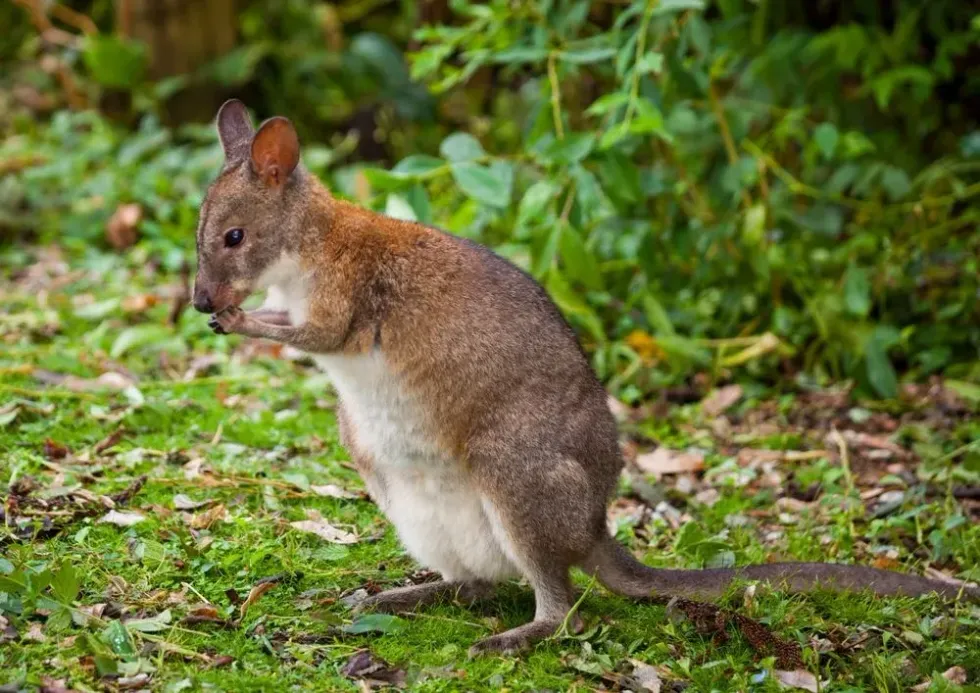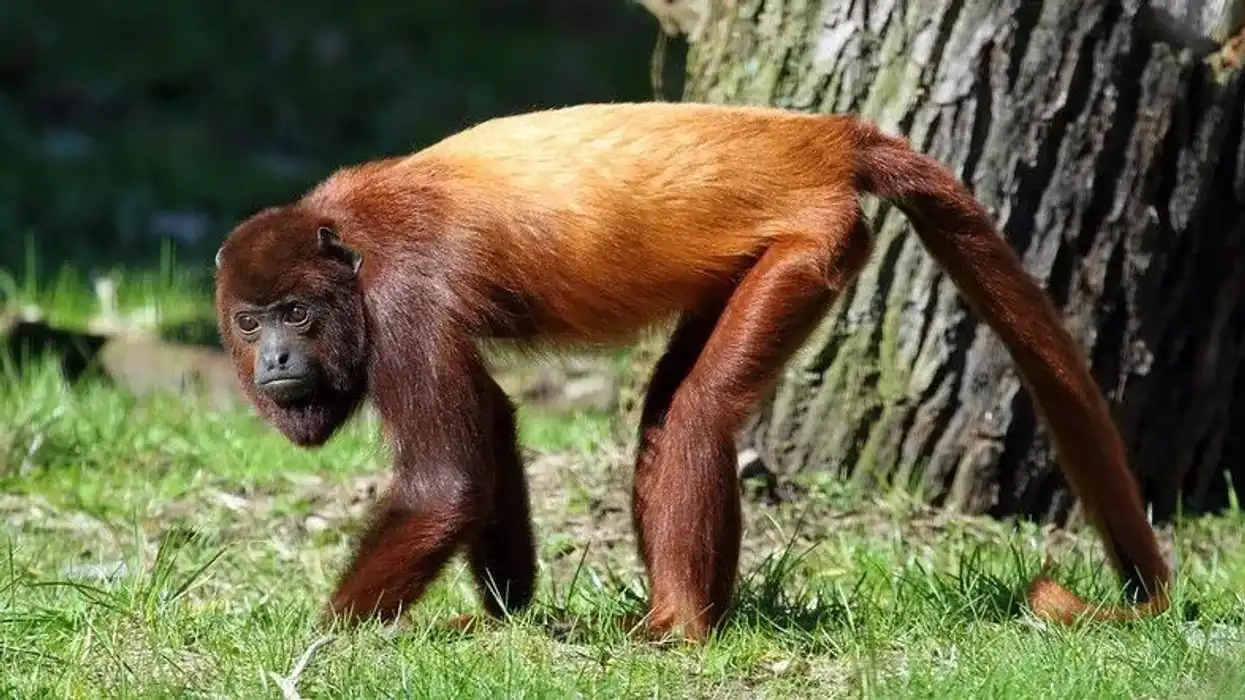In this article, we will learn about the red-necked pademelon, (scientific name - Thlogale thetis). Pademelon pronunciation is 'pad-ee-mel-uhn' Though everyone in the world knows about Kangaroos, wallabies, little is known about this marsupial named pademelon.
This red-necked marsupial is a lesser-known animal that lives in the eastern coastal region of Australia. These red-necked animals share similar body structures with kangaroo and wallaby but differ in size.
This species can mostly be found in temperate forests. They are very shy in nature and spend most of their time laying in leaf litter.
They also love to bask in the warm sunlight when the weather is cold. The word 'pademelon' originated from the word 'badimaliyan' in the Aboriginal language. Thylogale thetis has a brown-gray body with an underbelly that is cream in color.
As its name suggests, it has a distinct neck and shoulders that are tinted with a red color. The breeding season is usually autumn and spring.
They reach sexual maturity at 18 months of age. Tylogale thetis has been listed as 'Least Concern' by the International Union for Conservation of Nature (IUCN) in the Red List of Threatened Species.
Though the species number is currently not endangered, factors like habitat loss due to too many human activities like land clearance as well as predation by predators like fox and dingo are major threats. Keep reading to know more about this uniquely cute animal.
If you liked reading this article, be sure to check out the mahogany glider and hairy-nosed otter.
Red-Necked Pademelon Interesting Facts
What type of animal is a red-necked pademelon?
Red-necked pademelon is a marsupial and a small species of macropod.
What class of animal does a red-necked pademelon belong to?
Red-necked pademelon belongs to class Mammalia, infraclass Marsupialia, order diprotodontia and family Macropodidae.
How many red-necked pademelons are there in the world?
More research needs to be conducted to know the exact number of red-neck pademelons in the world. There are no sources currently that give us an idea of its population size. However, the red-necked pademelons are pretty common in their habitat and the population seems to be stable.
Where does a red-necked pademelon live?
Red-necked pademelons can be found in abundance in Eastern Australia. These animals can be spotted from Queensland to New South Wales.
What is a red-necked pademelon's habitat?
These animals, living in Eastern Australia can be found in grasslands, forests like eucalyptus forests, rainforests, or areas with thick shrubs.
Who does red-necked pademelon live with?
Red-necked pademelons lead solitary lives and spend most of the day sleeping in leaf litter. They also love basking in the warm sun when the temperature drops. These animals sometimes may be seen forming small groups.
How long does a red-necked pademelon live?
A red-necked pademelon in captivity has been recorded to live for about eight years. Red-necked pademelons however in captivity mostly have a life expectancy of about nine years.
How do they reproduce?
More research needs to be conducted to understand the mating systems in red-necked pademelons. The pademelon attains sexual maturity at the age of 18 months. Breeding usually takes place during the summer months in the South and the autumn and spring season in the north.
Birth is given to a single joey by the female pademelon. The young are altricial and themselves move to the mother's pouch from the birth canal. Inside the pouch, the joey can feed easily and also be protected.
What is their conservation status?
The International Union for Conservation of Nature (IUCN) has listed Red-necked pademelon as 'Least Concern' in the Red List of Threatened Species. Though their population is currently not endangered, habitual loss due to activities like land clearance as well as predation by dangerous predators like fox and dingo pose a major threat to their survival.
Red-Necked Pademelon Fun Facts
What does the red-necked pademelon look like?
The red-necked pademelon is a small marsupial. It has a brown-gray body. As its name suggests, its neck and shoulders are tinted with red. This macropod also has a cream underbelly. The red-necked pademelon is medium-sized and also has a short tail.
How cute are they?
These medium-sized marsupials with their short tails and distinct red-tinged neck and shoulders appear to be quite cute.
How do they communicate?
Communication between red-necked pademelons is done through different vocalizations. Mother red-necked pademelons make a clucking call to communicate with their young. The red-necked pademelon's males as well can be heard making soft clucking calls to attract potential mates. These animals also communicate with their hind feet. They thump their hind feet.
How big is a red-necked pademelon?
Red-necked pademelons are not too big in size and have a length between 11.4 in (29 cm) and 24.4 in (62 cm). They have a short tail in comparison to other marsupials, with a length of 10.6-20 in. ( 27-51 cm). They are way shorter than a kangaroo or red kangaroo.
How fast can a red-necked pademelon run?
Red-necked pademelons can move at very high speeds. A red-necked pademelon can travel at a speed of up to 34 mph (54.7 kph).
How much does a red-necked pademelon weigh?
The male red-necked pademelon size is bigger than the female and weighs about 15.4 lb (7 kg). Females, weigh much lesser at 8.3 lb (3.8 kg).
What are the male and female names of the species?
There are no specified or unique names that can be used to refer to the male and female thylogale thetis. However, similar to kangaroos, males and females may be referred to as jacks and does, bucks and boomers.
What would you call a baby red-necked pademelon?
A baby pademelon thylogale thetis may be referred to as 'joey'. The young or the joey stays inside the mother's pouch for feeding as well as for protection. The joey can stay inside the pouch for up to six and a half months.
What do they eat?
In thylogale thetis habitats' like grasslands and eucalyptus forests, the red-necked pademelon can be found foraging and feeding on grass, shrubs. They are primary consumers in the food cycle. Their diet also consists of leaves, barks, and roots.
Are they dangerous?
Red-necked pademleons thylogale thetis are shy in nature and lead solitary lives. They do not pose any danger or threat to human beings. However, when they venture out to forests to forage, they might kick harshly if they feel threatened by your presence.
Would they make a good pet?
The red-necked pademelon may be kept as pets. It is very important, however, to check with the laws of the state and the country you reside in as in some states, it may be illegal to own these cute marsupials.
If you are able to keep this animal as a pet, be sure to give it a large, enclosed area where it can hop around and spend its time. They also need to be provided with a good diet with an ample amount of grass, leaves, and root.
Did you know...
The red-necked pademelons thylogale thetis have tails that are shorter than the body length.
When it comes to pademelon vs quokka, both are small marsupials and have very few differences between them.
These pademelons at times play an important role in ecotourism for the areas they can be found in.
The pademelons use saltatorial locomotion for their movement.
The same route is used by this pademelon species while traveling to the feeding ground and while coming back from it.
As opposed to different macropods like kangaroos, the tail of the red-necked pademelon is not used as a third leg but is dragged instead.
Though pademelon and wallaby appear to be similar to each other, they can be differentiated on the basis of their tails. Pademelon has a much thicker, sparsely-haired as well as shorter tail than the wallabies.
The word 'pademelon' is derived from the word 'paddymlla' in the Aboriginal language. This word was used to refer to a small kangaroo from the forest.
Are pademelons friendly?
Pademelons thylogale thetis are shy creatures that are nocturnal and they lead solitary lives. They don't come in much contact with humans and even when they do, they do not cause any harm or present any sort of danger to them.
Different types of pademelon?
Pademelons are the lesser known marsupials. The scientific name of the pademelon comes from the Greek words for 'pouch'. There are different types of pademelons that can be found in various parts of Asustralia and New Guinea.
Brown's pademelon is found in New Guinea in tropical or subtropical dry forests, dry savanna, tropical or subtropical dry shrubland, and lowland grasslands.
Tasmanian pademelon or red-bellied pademelon is the only pademelon found in Tasmania. It has much thicker fur over its limbs, body, and head than its other family members.
Mountain pademelon is the pademelon that can only be found in Papua, New Guinea.
Calaby's pademelon is also known by the name of alpine wallaby. This species is endemic to Papua New Guinea.
Red-legged pademelon is found in the Northeastern coast of Australia as well as in New Guinea. This animal can mostly be found in rainforests, where it feeds on leaves, grasses, and fallen fruits. The red-legged pademelon has four subspecies as well.
Dusky pademelon can be found in the Trans-fly savanna and grasslands ecoregion as well as Aru and Kai islands.
Here at Kidadl, we have carefully created lots of interesting family-friendly animal facts for everyone to discover! For more relatable content, check out these white-footed dunnart facts and white-beaked dolphin facts for kids.
You can even occupy yourself at home by drawing one on our free printable mammal coloring pages.









